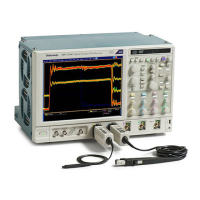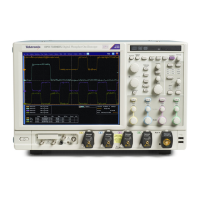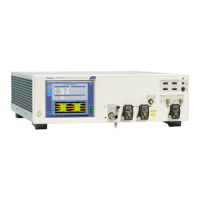Do you have a question about the Tektronix DPO7354C and is the answer not in the manual?
Provides general safety precautions to avoid injury and product damage during operation.
Contains additional information for safely performing service procedures on the product.
Provides essential precautions and techniques to prevent Electrostatic Discharge (ESD) damage to the instrument's input.
Outlines the procedure to run internal diagnostics and verify the instrument's functionality.
Explains the process of signal path compensation for accurate measurements, especially with high sensitivity settings.
Details how to connect probes and select input channels for acquiring analog signals.
Explains how to use the Autoset function to automatically configure acquisition, trigger, and vertical settings.
Describes FastAcq mode for capturing transient events and displaying phenomena based on rate-of-occurrence.
Guides users on connecting logic probes and setting up digital channels for signal acquisition.
Explains FastFrame mode for capturing multiple trigger events as individual records for later analysis.
Guides users on selecting and setting up various trigger types available on the instrument.
Details how to use A and B triggers for capturing more complex signals and sequential events.
Guides users on triggering based on parallel bus signals using digital channels.
Describes how to create trigger conditions directly on the display screen using visual trigger areas.
Explains how to configure the instrument to save files or send emails when specific events occur.
Details how to select channels and measurement categories for automated analysis.
Guides users on taking manual measurements using cursors on acquired data.
Describes how to display vertical or horizontal histograms for statistical analysis of waveform data.
Explains how to create and use math waveforms by combining and transforming source waveforms.
Details how to perform spectral analysis using predefined and advanced spectral math expressions.
Guides users on using the Serial Error Detector for analyzing serial data errors and compliance testing.
Explains how to compare signals to predefined masks for compliance testing.
Describes how to compare active signals with template waveforms for pass/fail testing.
Summarizes critical safety precautions for using the P6616 probe to prevent hazards.
Provides general safety precautions to avoid injury and product damage during operation.
Contains additional information for safely performing service procedures on the product.
Provides essential precautions and techniques to prevent Electrostatic Discharge (ESD) damage to the instrument's input.
Outlines the procedure to run internal diagnostics and verify the instrument's functionality.
Explains the process of signal path compensation for accurate measurements, especially with high sensitivity settings.
Details how to connect probes and select input channels for acquiring analog signals.
Explains how to use the Autoset function to automatically configure acquisition, trigger, and vertical settings.
Describes FastAcq mode for capturing transient events and displaying phenomena based on rate-of-occurrence.
Guides users on connecting logic probes and setting up digital channels for signal acquisition.
Explains FastFrame mode for capturing multiple trigger events as individual records for later analysis.
Guides users on selecting and setting up various trigger types available on the instrument.
Details how to use A and B triggers for capturing more complex signals and sequential events.
Guides users on triggering based on parallel bus signals using digital channels.
Describes how to create trigger conditions directly on the display screen using visual trigger areas.
Explains how to configure the instrument to save files or send emails when specific events occur.
Details how to select channels and measurement categories for automated analysis.
Guides users on taking manual measurements using cursors on acquired data.
Describes how to display vertical or horizontal histograms for statistical analysis of waveform data.
Explains how to create and use math waveforms by combining and transforming source waveforms.
Details how to perform spectral analysis using predefined and advanced spectral math expressions.
Guides users on using the Serial Error Detector for analyzing serial data errors and compliance testing.
Explains how to compare signals to predefined masks for compliance testing.
Describes how to compare active signals with template waveforms for pass/fail testing.
Summarizes critical safety precautions for using the P6616 probe to prevent hazards.
| Bandwidth | 3.5 GHz |
|---|---|
| Channels | 4 |
| Display Size | 12.1 inches |
| Input Coupling | AC, DC, GND |
| Sample Rate | 40 GS/s |
| Vertical Resolution | 8 bits |
| Input Impedance | 1 MΩ ± 1% |
| Display Type | LCD color display |
| Maximum Input Voltage | 5 Vrms |
| Trigger Modes | Edge, Pulse Width, Logic |
| Interface | USB, LAN, GPIB |
| Power Requirements | 100-240 VAC, 50/60 Hz |











